[Source: T The New York Times Style Magazine by Stephen Heyman | Images: Elle Decor Italia]
The interior architect Vincenzo de Cotiis — sought after in his native Italy for the dynamic monastery-meets-laboratory approach he brings to designing furniture, homes and hotels — deserves our attention.
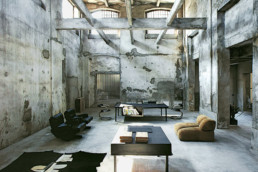
On a particularly hot day in Milan, the Italian designer, interior architect and sculptor of sorts Vincenzo de Cotiis, 56, perched himself on an industrial-style work stool in his gallery near Corso Como. The stool, which looked like an anvil looted from a futuristic construction site, was made out of solid aluminum, but while it was being forged, de Cotiis covered it in a webbed net, which gave it a surprisingly soft texture, a bit like fabric. “I’m not sure where the idea came from,” he told me. “I always start with the material and adjust the shape to fit. The shape comes second.”
The primacy of material over form gives de Cotiis’s pieces a kind of organic intrigue. Some seem almost to grow out of the floor, or to take on anthropomorphic dimensions: armchairs that smile; oxidized-brass suspension lamps that bend and twist, interrogating the spaces they illuminate. Because he uses recycled materials — salvaged wood, reclaimed leather, fiberglass sourced from shipyards — and crafts most of his pieces himself, each is incredibly rare, often produced in a series of no more than 10. He has collaborated with Italian furniture companies like Ceccotti Collezioni, Rossana Orlandi and Busnelli but prefers to work alone. “This may sound a bit undemocratic,” he said, “but I don’t like designing mass-produced pieces.”
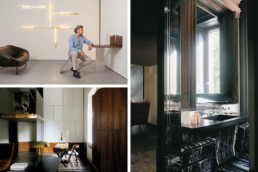
De Cotiis divides his work life between this gallery-quality furniture collection, Progetto Domestico, and his much more lucrative interior architecture practice. In Milan, he has helped pioneer the monastery-meets-laboratory aesthetic of the city’s most luxurious multibrand stores, such as Antonia in Brera and Excelsior Milano, converted from an old cinema near the Duomo. De Cotiis decorated both these spaces as temples to fashion — dramatically lit, a little clinical, with massive cement-block displays, exposed stone walls or archways, gleaming marble floors and translucent shelves on which bags and shoes are displayed like research specimens.
In his residential commissions, he places his rigorous, high-design furniture in spaces that are by turns lavish and spare. He has decorated homes with walls so raw they look like the basement from “Fight Club,” but has also created rich, warm, family-friendly residences. The apartment he made for one client is filled with many of de Cotiis’s signatures: framed panels of weathered aluminum, swervy desks, suspended cabinets of brushed recycled wood and an improbably long and narrow dining room table. There’s the same blend of smooth and rough — in the walls of oxidized mirror or bare concrete, and in the split-personality bathroom, with its vanity mirror encased in a rusticated wooden pilaster above an almost comically luxurious black and white marble floor.
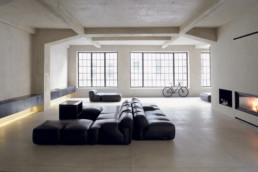
De Cotiis is currently at work on a boutique hotel in Shenzhen, China — part of a $3.2 billion commercial and residential complex master-planned by Skidmore, Owings & Merrill (SOM). Marissa Morelli, the supervising architect in his office, spends much of her time trying to focus his considerable energies. “It’s never linear. It’s not an architect’s way of designing,” she said. “It’s closer to art.” For many years, Morelli said, de Cotiis didn’t bother to photograph his work, not even his cult-fashion collection, Haute, from the mid-2000s, which featured torn and washed silk and cashmere, antique lace and glass. Sometimes he dissolved 1980s fabrics in acid and used the leftover materials as a kind of ghostly shroud. It was painstaking, poetic, intellectually daring work. “And he has almost no pictures of it — nothing,” she said. “I think for him the process of designing is much more interesting than the end product.”
Which is not to say de Cotiis doesn’t care about the details. Near the gallery, he has eight designers and architects working in a cramped studio so laden with art tomes that it’s often mistaken for a bookstore by passers-by. When I asked them whether de Cotiis is a demanding boss, they lowered their eyes and giggled nervously, as if to say, You have no idea. De Cotiis will often submit sketches to his staff — little line drawings of, say, a curvy armchair — opposite photos of leather handbags from the 1950s. (He has a huge archive of inspirational bric-a-brac in the basement of the studio.) “Sometimes it’s hard to see the connection,” Morelli said.
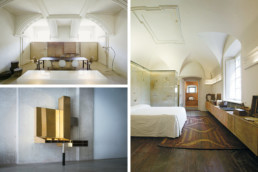
De Cotiis remembers sketching from a very early age. “Whatever I saw around me, I copied: famous paintings, historical movements in art, the Impressionists, anything.” He spent a year studying art in Venice (which he deemed “too classical”) before enrolling in the architecture department of Milan’s famous Politecnico, the elite engineering and design school that trained generations of Italian visionaries including Giò Ponti and Achille Castiglioni.
The first space he designed after graduating was a friend’s boutique in Brescia. The store was starkly minimalist: all white, two sofas, two tables. “The clothes were only presented on mannequins, no racks,” he recalled. “The mannequins had Japanese features.” Sergio Gandini, a former partner and chairman of Flos, an Italian lighting firm, was so impressed that he opened a studio for de Cotiis, launching his career.
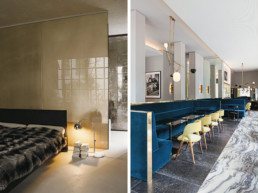
In Milan, de Cotiis took on the décor for a restaurant in the space that currently houses Excelsior. “It was very new for Milan: the first place to serve Mexican, Thai and Japanese food.” The project, he said, was so radical that “people didn’t understand what it was.” He describes the space: “There were two rooms: one completely red — floors, walls, everything — the other completely white. Very minimal. Probably too minimal.” In the past several years, de Cotiis has been branching out of shop design. “Now fashion has become very business,” he said. “Everything is so calculated. There’s no risk.”
De Cotiis usually spends half the week in his two workshops in the countryside, which he calls his “laboratories.” In recent years, he has created everything from industrial-size, weathered-brass kitchen islands to giant tableaux of incandescent filmstrips covered in resin, which he frames like paintings. “I’ve been quite emotional in my choices,” de Cotiis told me, trying to explain what drives his creative decisions. “Everything is always evolving around you, you have to absorb these changes, but I have tried to maintain my way of doing things. There is often no reason, no why, in these things.”